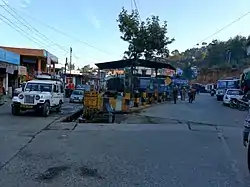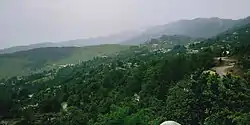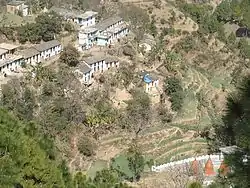Pithoragarh district
Pithoragarh district is the easternmost district in the state of Uttarakhand. It is located in the Himalayas and has an area of 7,110 km2 (2,750 sq mi) and a population of 483,439 (as of 2011). The city of Pithoragarh, located in Saur Valley, is its headquarters. The district is within the Kumaon division of Uttarakhand state. The Tibet plateau is situated to the north and Nepal is to the east. The Kali River which originates from the Kalagiri Mountain flows south, forming the eastern border with Nepal.[2] The Hindu pilgrimage route for Mount Kailash-Lake Manasarovar passes through this district via Lipulekh Pass in the greater Himalayas. The district is administratively divided into six Tehsils: Munsyari; Dharchula; Didihat; Berinag; Gangolihat; and Pithoragarh. Naini Saini Airport is the nearest civil airport, but it does not have a regular scheduled commercial passenger service. The mineral deposits present in the district are magnesium ore, copper ore, limestone, and slate. There are 11 tehsils.
Pithoragarh district | |
|---|---|
     Panchchuli peaks at Sunset from Chaukori, View of Didihat, sunrise over Pithoragarh, view of Munsiyari, street in Berinag | |
| Nickname: Mini Kashmir | |
.svg.png.webp) Location in Uttarakhand | |
| Coordinates: 30°00′N 80°20′E | |
| Country | |
| State | Uttarakhand |
| Division | Kumaon |
| Headquarters | Pithoragarh |
| Government | |
| • District collector | Reena Joshi, IAS[1] |
| Area | |
| • Total | 7,110 km2 (2,750 sq mi) |
| Population (2011) | |
| • Total | 483,439 |
| • Density | 69/km2 (180/sq mi) |
| Languages | |
| • official | Hindi |
| • Native | Kumaoni |
| Time zone | UTC+5:30 (IST) |
| PIN | 262501 |
| Telephone code | 91 5964 |
| Vehicle registration | UK-05 |
| Website | pithoragarh |
Etymology
Some attribute the name to King Prithvi Pal (Had his empire to Nainital & parts of UP) / Piru Gusain (Gusain refers to the younger son of a King), here the younger son of King of Askote (Pal)/ Pithora Shahi/ Pithora Chand from the Chand Dynasty, who built a fort named Pithora Garh in the Saur Valley.
History
Pals (Branch of Katyuri kings)
After its conquest by Bhartpal, the Rajwar of Uku (now in Nepal), in the year 1364, Pithoragarh was ruled for the rest of the 14th century by three generations of Pals, and the kingdom extended from Pithoragarh to Askot.
Bam Dynasty

According to a Tamra Patra (inscribed copper or brass plaque) from 1420, the Pal dynasty, based out of Askot, was uprooted by Chand kings. Vijay Brahm (of the Brahm dynasty from Doti) took over the empire as King. Following the death of Gyan Chand, in a conflict with Kshetra Pal, the Pals were able to regain the throne.
Chand Dynasty
It is believed that Bharti Chand, an ancestor of Gyan Chand, had replaced Bams, the ruler of Pithoragarh, after defeating them in 1445. In the 16th century, the Chand dynasty again took control over Pithoragarh town and, in 1790, built a new fort on the hill where the present Girls Inter College is situated. The Chand rule, at its zenith, is seen as one of the most prominent empires in Kumaon. Their rule also coincides with a period of cultural resurgence. Archaeological surveys point toward the development of culture and art forms in this period.
Modern history
British rule began on 2 December 1815 when Nepal was forced to sign the Sugauli Treaty. Pithoragarh remained a tehsil under Almora district until 1960 when its status was elevated to that of a district. There was an army cantonment, a church, and a mission school, resulting in the spread of Christianity in the region.
The Bhotiya communities living in the Pithoragarh district historically practised transhumance between summer villages located at higher altitudes, close to the border with Tibet, and winter settlements located at lower altitudes, close to the Himalayan foothills and the Gangetic plains. With transhumance as a base, many of them would engage in annual trade visits to market towns such as Taklakot in western Tibet, and some would practice nomadic pastoralism as well. This way of life came to an abrupt end in the 1962 due to the Sino-Indian War. Trans-Himalayan trade was allowed again since the under 1990s. But unlike in the past, it was now to be conducted under state-imposed regulations and limitations, and was allowed only across the Pithoragarh district's Lipu Lekh pass, whereas in earlier times, in Kumaon and Garwhal, the Trans-Himalayan trade had been conducted across several passes.[3]
In 1997, part of the Pithoragarh district was cut out to form the new Champawat district.
Demographics
| Year | Pop. | ±% p.a. |
|---|---|---|
| 1901 | 135,083 | — |
| 1911 | 156,541 | +1.49% |
| 1921 | 157,943 | +0.09% |
| 1931 | 173,716 | +0.96% |
| 1941 | 204,684 | +1.65% |
| 1951 | 230,180 | +1.18% |
| 1961 | 274,226 | +1.77% |
| 1971 | 313,747 | +1.36% |
| 1981 | 365,141 | +1.53% |
| 1991 | 416,647 | +1.33% |
| 2001 | 462,289 | +1.04% |
| 2011 | 483,439 | +0.45% |
| source:[4] | ||
According to the 2011 census Pithoragarh district has a population of 483,439, roughly equal to the nation of Suriname.[6] This gives it a ranking of 546th among the 640 Districts of India. The district has a population density of 69 inhabitants per square kilometre (180/sq mi). Its population growth rate over the decade 2001–2011 was 5.13%. Pithoragarh has a sex ratio of 1021 females for every 1000 males, and a literacy rate of 82.93%. Scheduled Castes and Scheduled Tribes make up 24.90% and 4.04% of the population respectively.[7]
Native tribes in the district include the Van Rawats and Shaukas. Van Rawats are hunter-gatherers. Shaukas are traders. In Pithoragarh the Shaukas are divided into two main tribes. Johari Shaukas and Rung Shaukas. The Johari Shauka community inhabits the areas in Munsiyari while Rung Shaukas tribe are spread among the three valleys of Darma, Chaundas, and Byans. Kangdali Festival, celebrated once every 12 years by inhabitants of Chaundas Valley, is one of the major festivals in this area.
Languages
Kumaoni, with its several dialects, is the most widely spoken language.[8] Hindi is the common language between the locals and outsiders, and English is spoken by some people, especially teachers, lecturers, and students in tertiary education.
Several Sino-Tibetan languages of the West Himalayish branch are spoken by small communities. These include the three closely related languages of Byangsi, Chaudangsi, and Darmiya, as well as Rangkas & Rawat.[9] The Van Rawat tribe speaks their own variety of Kumaoni.
| Pithoragarh district: mother-tongue of population, according to the 2011 Indian Census.[8] | |||
|---|---|---|---|
| Mother tongue code | Mother tongue | People | Percentage |
| 002007 | Bengali | 414 | 0.1% |
| 004001 | Dogri | 396 | 0.1% |
| 006102 | Bhojpuri | 1,654 | 0.3% |
| 006195 | Garhwali | 1,634 | 0.3% |
| 006240 | Hindi | 35,590 | 7.4% |
| 006340 | Kumauni | 423,862 | 87.7% |
| 006439 | Pahari | 653 | 0.1% |
| 013071 | Marathi | 281 | 0.1% |
| 014011 | Nepali | 7,259 | 1.5% |
| 016038 | Punjabi | 383 | 0.1% |
| 022015 | Urdu | 1,224 | 0.3% |
| 031001 | Bhotia (also called "Jad") | 1,325 | 0.3% |
| 046003 | Halam | 5,623 | 1.2% |
| 103003 | Rai | 263 | 0.1% |
| – | Others | 2,878 | 0.6% |
| Total | 483,439 | 100.0% | |
Assembly Constituencies
- Dharchhula
- Didihat
- Pithoragarh
- Gangolihat (SC)
Climate
Pithoragarh town, being in a valley, is relatively warm during summer and cool during winter. During the coldest months of December and January, the tropical and temperate mountain ridges and high locations receive snowfall and have an average temperature of 5.5–8.0 °C (41.9–46.4 °F). Pithoragarh district has extreme variation in temperature due to the wide range of variations in altitude. The temperature rises from mid-March through mid-June. The areas above 3,500 metres (11,500 ft) remain in a permanent snow cover. Regions lying at 3,000–3,500 metres (9,800–11,500 ft) become snowbound for four to six months. At places like the river gorges at Dharchula, Jhulaghat, Ghat and Sera, temperatures reach 40 °C (104 °F). The annual average rainfall in lower reaches is 360 centimetres (140 in).Sati, Vishwambhar Prasad; Kumar, Kamlesh (2004). Uttaranchal: Dilemma of Plenties and Scarcities. ISBN 8170998980. After June the district receives monsoon showers. Winter is a time for transhumance – the seasonal migration of the Bhotiya tribe with their herds of livestock to lower, warmer areas.
Seasons
- Winter (cold weather): December–March
- Summer (hot weather): March–June
- Season of general rains: North–West monsoon – mid-June to mid-September
- Season of retreating monsoon: September–November
Glaciers of Pithoragarh
Locally, glaciers are known as Gal. Some important glaciers of the district are as follows:
- Milam Glacier
- Namik Glacier
- Ralam Glacier
- Meola Glacier
- Sona Glacier
- Panchchuli Glacier
- Balati Glacier
- Shipu Glacier
- Rula Glacier
- Kalabaland Glacier
- Lawan Glacier
- Northern Lwanl
- Middle Lwanl
- Lower Lwanl
- Bamlas Glacier
- Baldimga Glacier
- Terahar Glacier
- Poting Glacier
- Talkot Glacier
- Sankalpa Glacier
- Lassar Glacier
- Upper Lassar
- Lower Lassar
- Middle Lassar
- Dhauli Glacier
- Baling Golfu Glacier
- Dhauli Glacier
- Sobla Tejam Glacier
- Kali Glacier
- Kuti Glacier
- Yangti Basin Glacier
- Lower Dhauli
- Middle Dhauli
- Upper Dhauli
- Lower Kali
- Upper Kali
Himalayan peaks of Pithoragarh
| Peak | Height (m) |
|---|---|
| Sunanda Devi | 7,434 |
| Hardeol | 7,151 |
| Trishuli | 7,099 |
| Rishi Pahar | 6,992 |
| Panchchuli II | 6,904 |
| Nanda Kot | 6,861 |
| Chiring We | 6,559 |
| Rajrambha | 6,537 |
| Chaudhara | 6,510 |
| Sangthang | 6,480 |
| Panchchuli V | 6,437 |
| Nagalaphu | 6,410 |
| Suitilla (Suj Tilla West) | 6,374 |
| Suj Tilla East | 6,393 |
| Panchchuli I | 6,355 |
| Bamba Dhura | 6,334 |
| Burphu Dhura | 6,334 |
| Panchchuli IV | 6,334 |
| Changuch | 6,322 |
| Nanda Gond | 6,315 |
| Panchchuli III | 6,312 |
| Nanda Pal | 6,306 |
| Suli Top | 6,300 |
| Kuchela | 6,294 |
| Nital Thaur | 6,236 |
| Kalganga Dhura | 6,215 |
| Jonglingkong or Baba Kailash | 6,310 |
| Om Parvat | 6,191 |
| Lalla We | 6,123 |
| Kalabaland Dhura | 6,105 |
| Telkot | 6,102 |
| Bainti | 6,079 |
| Ikualari | 6,059 |
| Nagling | 6,041 |
| Menaka Peak | 6,000 |
| Trigal | 5,983 |
| Yungtangto | 5,945 |
| Sankalp | 5,929 |
| Laspa Dhura | 5,913 |
| Sahdev | 5,782 |
| Ralam Dhura | 5,630 |
| Gilding Peak | 5,629 |
| Shivu | 5,255 |
| Tihutia | 5,252 |
| Draupadi Peak | 5,250 |
| Rambha Kot | 5,221 |
| Panchali Chuli | 5,220 |
| Gelding | 50,29 |
| Dunkhan | 5'035 |
| Halsyun | 5'105 |
| Lalla We | 6'123 |
| Adi Kailash | 6'321 |
| Rajrambha | 6'537 |
| Deo Damia | 6'632 |
| Bamchhu | 6'302 |
| Syakaram | 6'258 |
| Mangron | 6'565 |
| Latu Dhura | 6'389 |
| Bati ka Dhura | 5'858 |
| Nanda Lapak | 5'782 |
| Kalchhu Dhura | 5'421 |
| Mapa Dhura | 5'206 |
Mountain passes of Pithoragarh
International passes to Tibet
| Pass | Height (m) |
|---|---|
| Lampiya Dhura | 5,530 |
| Lipu-Lekh pass | 5,450 |
| Lowe Dhura | 5,562 |
| Mangshya Dhura | 5,630 |
| Nuwe Dhura | 5,650 |
| Kungri Bingri Pass | 5,564 |
Intra-district Himalayan passes
| Pass | Height (m) |
|---|---|
| Ghantesh Baba | 5,164 |
| Nama pass | 5,500 |
| Sinla pass | 5,495 |
| Ralam pass | 5,630 |
| Keo Dhura | 5,439 |
| Belcha Dhura | 5,384 |
| Kalganga Dhura | 5,312 |
| Traills pass | 5,312 |
| Gangchal Dhura | 5,050 |
| Birejrang Dhura | 4,666 |
| Ghatmila Dhura | |
| Unta Dhura | 5,350 |
| Yangkchar Dhura | 4,800 |
| Rur Khan | 3,800 |
| Bainti Col | 5,100 |
| Longstaff Col | 5,910 |
Valleys of Pithoragarh
- Vyas valley (includes Kuthi Valley and the valley of Kalapani River)
- Kuti-Yangti Valley : Kuti-Yangti valley has 112 glaciers. The passes of Kuti valley Lampiya Dhura (5,553 m), Nuwe Dhura (5,650 m)
- Chaudans valley
- Darma Valley
- Goriganga valley : Goriganga has 128 glaciers with largest Milam glacier having 18 km in length.
- Dhauliganga valley : Those are source of several streams and rivers. Maximum 135 glaciers found in the Dhauliganga valley.
- Johar Valley
- Kalabaland valley
- Kali valley : Lipu Lekh Pass (5,122 m) (India, Tibet, Nepal)
- Lassar Yangti valley
- Ralam valley
- Saur valley
- Ramganga valley :There are 7 glaciers in Ramganga valley and Namik is largest with 2.4 square Km in size.
- Saryu /Sarju Valley
- Gori Gunkha valley : Belcha Dhura pass (5,384 m), Kungri Bhingri Pass (5,564 m), Keo Dhura pass (5,439 m)
Flora
A wide variety of flora exists in the district, including many unique sub-tropical, temperate, and alpine plants. Bryophytes (mosses), pteridophytes (ferns), gymnosperms (conifers), and angiosperms (flowering plants) are present. Rare varieties of orchids are also present in the high-altitude valleys of Milan, Darma, Beyans, and Kuthi. Species present include:
- Abies pindrow
- Aconitum heterophyllum
- Berberis aristata (Kirmod)
- Betula utilis (Himalayan birch or Bhoj Patra)
- Cedrus deodara (Deodar Cedar)
- Cypripedium cordigerum
- Dendrobium normale
- Myrica esculenta (Kafal)
- Nardostachys grandiflora (Jatmasi)
- Pedicularis punctata
- Picrorhiza kurroa (Kutki)
- Pinus roxburghii (Salla or Chir)
- Pinus wallichiana (Blue Pine or Raisalla)
- Prunus cornuta
- Prunus puddum
- Quercus dilatata
- Quercus incana
- Quercus leucotricophora (Banjh)
- Quercus semicarpifolia
- Rhododendron barbatum (Burans)
- Rhododendron campanulatum
- Rubus ellipticus (Hisalu)
- Saussurea obvallata (Brahm Kamal)
- Saussurea simpsonia
- Taxus wallichiana (Himalayan yew)
- Vanda cristata
- Zanthoxylum armatum (Timur)
- 10–15 kinds of cactus
- Aadu
- Different type of pulses like red and green lentils
- Figs
- Green apples
- Himalyan pears
- Mulberry
- Oranges
- Peaches
- Red apples
- Rye (a local staple)
- Simal
- Soy beans
- Yellow plums
Tourist attractions
- Askot Musk Deer Sanctuary is a 599.93 km2 wildlife sanctuary located around Askot near Didihat, in Pithoragarh district of the Himalaya of Kumaon in Uttarakhand, India.
- Berinag is a hill station located 102 km from Pithoragarh at an altitude of 2010 m.[10]
- Chaukori is a hill station located 10 km from Berinag, also with an altitude of 2010 m.
- Munsyari is a hill station in the northern part of the Pithoragarh district. The valley from Munsyari to Milam is known as Johar Valley.
- Pithoragarh Fort is set atop a hill on the outskirts of the town and now serves as a museum.
- Mostamanu Temple is a hindu temple dedicated to Mosta, an avatar of Lord Shiva.[11]
Notable people
- Anjali Tatrari - Television actress
- General Bipin Chandra Joshi, PVSM, AVSM, ADC - 17th Chief of Army Staff, Indian Army
- Dan Singh Bisht - businessman and philanthropist
- Lucky Bisht - NSG commando and spy
- Nain Singh Rawat - explorer
- Prakash Pant - politician
- Ratan Singh Raypa - anthropologist
- Shekhar Pathak - historian, editor, travel writer, activist
- Unmukt Chand - cricketer
- Vinod Kapri - filmmaker, journalist, and author
References
- "सीमांत जिले पिथौरागढ़ में पहली बार महिला जिलाधिकारी तैनात, बागेश्वर में भी महिला डीएम, देखें किसे मिली कमान". Dainik Jagran (in Hindi). Retrieved 29 October 2022.
- Hoon, Vineeta (1996), Living on the Move: Bhotiyas of the Kumaon Himalaya, Sage Publications, p. 48, ISBN 978-0-8039-9325-9: "The river Kaliganga forms a natural boundary between India and Nepal. It has two headwaters: the eastern one Kalapani is a collection of springs, and the western one Kutiyankti [Kuthi Yankti] rises from the snow fields of the Himadri near Kuti, the last Bhotiya village in Vyas."
- Pandey, Abhimanyu; Pradhan, Nawraj; Chaudhari, Swapnil; Ghate, Rucha (2 January 2017). "Withering of traditional institutions? An institutional analysis of the decline of migratory pastoralism in the rangelands of the Kailash Sacred Landscape, western Himalayas". Environmental Sociology. 3 (1): 87–100. doi:10.1080/23251042.2016.1272179.
- Decadal Variation In Population Since 1901
- "Table C-01 Population by Religion: Uttarakhand". censusindia.gov.in. Registrar General and Census Commissioner of India. 2011.
- US Directorate of Intelligence. "Country Comparison:Population". Archived from the original on 13 June 2007. Retrieved 1 October 2011.
Suriname 491,989 July 2011 est.
- "District Census 2011". Census2011.co.in. 2011. Retrieved 30 December 2012.
- "Table C-16 Population by Mother Tongue: Uttarakhand". www.censusindia.gov.in. Registrar General and Census Commissioner of India.
- Eberhard, David M.; Simons, Gary F.; Fennig, Charles D., eds. (2019). "India – Languages". Ethnologue (22nd ed.). SIL International.
- "Berinag Travel Guide - Berinag Uttarakhand Tourism, Travel Tips". www.euttaranchal.com. Retrieved 14 February 2022.
- "Mostamanu Temple Pithoragarh | Mosta Manu Mandir Travel Guide". www.euttaranchal.com. Retrieved 14 February 2022.